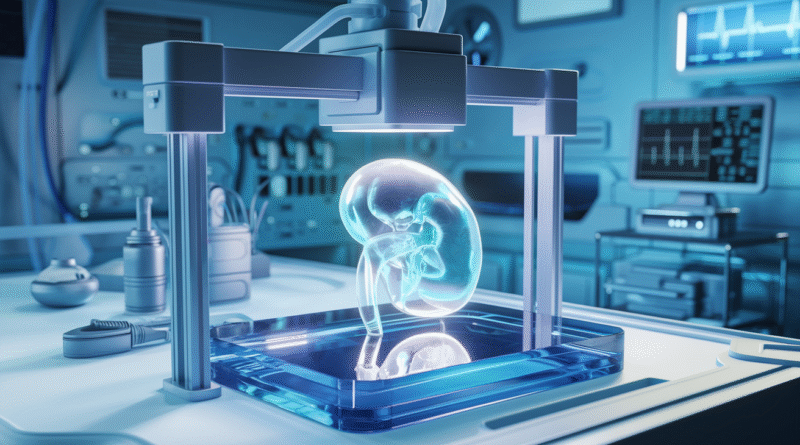3D Printing Organs : The Future of Organ Transplantation?
The concept of 3D printing organs, which once seemed like the realm of science fiction, is quickly evolving into a potential game-changer for healthcare. For decades, the field of organ transplantation has struggled with issues such as long waiting lists, donor shortages, and the risk of organ rejection. 3D bioprinting, a technique that uses specialized bioinks to print living tissues, offers a promising solution to many of these challenges. It envisions a future where organs could be custom-printed on demand, providing life-saving options tailored to each patient’s unique biological makeup.
Positioned at the crossroads of biology, engineering, and medicine, 3D organ printing remains in the experimental phase, but progress is being made rapidly. Although fully functional organs have yet to be successfully transplanted into humans, researchers are already able to print simpler tissues like skin and cartilage. As advancements continue, the ability to create more complex organs, such as kidneys, hearts, and lungs, appears within reach, offering profound implications for healthcare.
The Progression of 3D Printing in Medicine
3D printing technology has been utilized in various fields, including manufacturing and aerospace, for years. Its medical applications began with the production of devices and prosthetics, with surgeons using 3D-printed models to practice intricate procedures. This paved the way for bioprinting, where living cells and biological materials are used to generate functional tissues.
Bioprinting begins with a digital model of the organ or tissue, which guides the printer as it deposits bioink layers. These layers, containing living cells and growth factors, gradually form the desired tissue. While 3D printing in traditional fields uses materials like plastic or metal, bioprinting creates living tissues capable of integrating with a patient’s body.
Successful bioprinting efforts have already produced skin, cartilage, and bone tissues, which have been used in research and some clinical settings. However, the ultimate aim is to create fully functional, transplantable organs—an ambitious goal that presents both immense challenges and vast potential.
Tackling the Organ Shortage
A major driving force behind 3D organ printing is the global shortage of donor organs. Millions of people worldwide require transplants, yet only a small fraction receive them. In the U.S., over 100,000 people are on the waiting list, and many die before receiving a suitable organ. 3D bioprinting could eliminate this waiting period, saving countless lives.
This technology also holds the promise of producing organs customized to a patient’s genetics, which could minimize the risk of organ rejection. Currently, transplant recipients face the threat of their immune systems attacking the foreign tissue, necessitating the use of immunosuppressive drugs. Bioprinting an organ from a patient’s own cells would eliminate this risk and the need for long-term medication.
Moreover, 3D bioprinting allows for organs to be designed with precise dimensions, ensuring they fit perfectly within the patient’s body—an improvement over current donor organs, which may not always match in size or compatibility, leading to further complications.
Advances and Breakthroughs
While the complete 3D printing of functional organs remains a challenge, significant advancements have been made. One major obstacle is creating the vascular networks required to sustain an organ. Simple tissues like skin and cartilage do not require intricate blood vessel systems, but organs like the heart, liver, and kidneys rely on a complex network of vessels to function properly. Researchers are making progress in developing these vascular systems, and it’s believed that fully vascularized tissues could be achievable within a decade.
Another area of progress is the development of organoids, which are miniature versions of organs used for research and drug testing. These organoids have been successfully printed for organs like the liver and kidneys, serving as valuable tools for studying diseases and treatments. Though they are not yet viable for transplantation, they represent a significant step toward the creation of full-sized organs.
In 2019, Israeli scientists achieved a major breakthrough by 3D printing a small-scale heart using a patient’s own cells. Although it lacked the ability to pump blood, the heart featured essential components such as chambers and blood vessels. This milestone marks progress toward the eventual creation of functional organs.
Challenges and Ethical Considerations
Despite the excitement surrounding 3D-printed organs, significant technical and ethical challenges remain. A primary technical hurdle is ensuring that printed organs are not only structurally accurate but also functional, capable of performing complex tasks like filtering toxins or pumping blood.
Ethical questions arise around access to this technology. Will 3D-printed organs be available to everyone, or will they be accessible only to those who can afford them? Additionally, the use of human cells in bioprinting presents ethical dilemmas. Should genetically modified cells or animal cells be used, and how should these innovations be regulated to ensure ethical and responsible practices?
As bioprinting continues to evolve, clear regulations will be necessary to safeguard patient safety. Governments and regulatory bodies must strike a balance between fostering innovation and protecting public health.
The Future of 3D-Printed Organs
The future of 3D-printed organs holds incredible promise. Experts predict that within the next decade or two, functional organs may become a reality, transforming transplantation. In the short term, bioprinting will likely have a significant impact on drug testing and research, offering more accurate results than animal testing and accelerating drug development.
In the long term, 3D printing could resolve the organ shortage crisis, making it possible for patients to receive custom-printed organs matched to their genetic profiles. This would eliminate the need for immunosuppressive drugs and reduce the risk of complications, revolutionizing personalized medicine.
Conclusion
The emergence of 3D printing in organ transplantation represents one of the most exciting advancements in modern medicine. Though there are still technical and ethical hurdles to overcome, the potential benefits are immense. From addressing the organ donor shortage to revolutionizing drug testing and personalized healthcare, 3D bioprinting is set to reshape the future of medicine. As breakthroughs continue, the dream of printing functional organs is becoming closer to reality, offering new hope to millions of patients worldwide.

